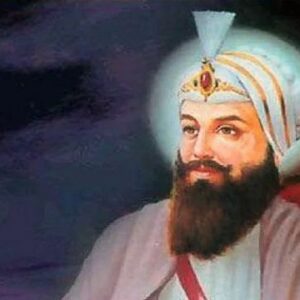Guru Hargobind was the sixth Sikh guru, and he was the first one to fight. People say that he set up the first Sikh army, which gave the group its military identity. He was very afraid of the Mughal forces because the Mughal Emperor Jahangir had tortured and killed his father, Guru Arjan Dev. After his father died, Guru Gaddi became the new leader at the young age of 11. He chose to wear a sword instead of the Seli of Guru Nanak Dev, which had been used by the other gurus before him. After the peaceful and holy Guru Arjan Dev was brutally tortured and killed, the Sikhs had to start a military tradition in order to face the Mughals and fight Islamic persecution. He put a lot of importance on the Sikhs learning martial arts, and he himself became a skilled swordsman, wrestler, and rider. The Sikhs fought and won several battles against the army of the Mughal Emperor Jahangir while he was in charge and with his help. He helped the Sikhs get stronger, and with him as their leader, the Sikhs became a kind of independent state inside the Mughal Empire. As the guru, he set up group prayers and sent his followers to faraway places to teach the Sikhism teachings.
Early years and childhood
Hargobind was born in Guru Ki Wadali, Amritsar, Punjab, India, on July 5, 1595. He was Arjan Dev and Mata Ganga’s only son. The fifth Guru of the Sikhs was his father.
When Hargobind was growing up, there were problems between the Mughal rulers and the Sikhs. Guru Arjan Dev was taken away by the Mughal Emperor Jahangir and brutally tortured when Hargobind was only 11 years old. Guru Arjan Dev chose Hargobind as his successor on May 25, 1606. A few days later, on May 30, Guru Arjan Dev was killed.
Guru Arjan Dev knew that the Mughals were a threat to the Sikhs before he died. He told his son to teach the Sikhs martial arts and build a strong army.
A Years After
On June 24, 1606, Guru Hargobind’s ceremony to hand over power to the next Guru took place. Baba Buddha did the rituals when the new guru asked him to dress him with a sword instead of the Seli of Guru Nanak Dev, which had been used by the other gurus before.
Guru Hargobind then put on two swords, one on his right and one on his left. These swords stood for temporal (miri) power and spiritual power (piri). When he became Guru Gaddi, he put a lot of weight on the Sikhs’ physical and military training. He worked hard to learn how to fight, ride, and use a sword well.
Before that, Sikhs were a peaceful group. But because the Mughals tortured and killed Guru Arjan Dev, the community had to start a military tradition to stand up to the Islamic persecution.
Guru Hargobind started building a strong army of young, healthy warriors right away, and he also got a lot of horsemen. He also got 60 gunners and 500 infantrymen from the area of Majha in the Punjab.
He made his cities stronger and built a fort called Lohgarh near Amritsar. Through his leadership and determination, he gave his followers the desire to fight against evil to protect their rights. The Mughals were very worried about how strong the Sikhs were getting, and they came to see them as a major threat.
Jahangir had the guru arrested and put in jail for several years at Gwalior Fort. Over time, Jahangir became more lenient, and in 1611 or 1612, he finally let the guru go. When he was freed, he told the Mughal emperor that the 52 Rajas who were being held as hostages in the fort because they were against the Mughal Empire should also be set free.
Jahangir died in 1627, and Shah Jahan, who took over after him, started to punish the Sikhs again. Guru Hargobind was angry at the horrible things the Mughals did, so he reorganized his army and fought the Mughals in several battles in Amritsar, Kartarpur, and other places.
Guru Hargobind led a strong Sikh army that won many battles against the Mughals, including the fierce Battle of Amritsar (1634). He also led the brave fight at the Battle of Kartarpur, which he won.
During his time in charge, the Sikh community not only grew in size but also started to act as its own thing within the empire. Because he did so much for Sikhism, the guru was given the name “Saccha Padshah” (True Emperor).
His Major Fights
The Sikhs fought against Mukhlis Khan in the Battle of Amritsar. This was one of the guru’s most important victories as the leader of a military group. The fights started over hawks but quickly turned into a full-blown war. After a lot of fighting, the guru killed Khan, giving the Sikh people a victory.
When Paine Khan’s Mughal army attacked Kartarpur in 1635, Guru Hargobind, his son Baba Gordita, and Bhai Bidhi Chand helped defend the city. The Mughals suffered a lot of damage as a result.
Personal History and Legacies
Some historians say Guru Hargobind was married three times, while others say this is not true. Mata Nanaki, Mata Mahadevi, and Mata Damodari are the names of his wives. He had a lot of children.
He passed away on March 19, 1644. He was the Sikh Guru for the most time, 37 years, 9 months, and 3 days. Guru Hargobind chose his grandson Har Rai to be his successor just before he died.
He built the Akal Takht, which is one of the Sikhs’ five centers of power, and started the city of Kiratpur.
Estimated Net worth
Unknown.


